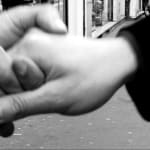
Halida Boughriet
DAHA FAZLA GÖRSEL
Action (6’9, 2003) is a black-and-white performance filmed on the streets of Paris. The protagonist is Halida Boughriet, who, while walking on the crowded streets, tries to establish contact with the passers-by by touching their hands. The scenes are filmed from a small distance, whereas the camera is unstable, producing a reportage, “hidden camera” effect. The faces are only occasionally shown for a short moment, the image being focused rather on the subjects’ body language, that mostly suggest refusal to interact with the artist and the wish to step back. The hurried steps, the reticence to be touched by a stranger as well as the harsh electronic soundtrack mirror the reality of the contemporary society: indifference and rejection that lead to alienation.
When watching the performance – according to critic Etienne Sandrin - we can easily trace elements from the action art of the 60’s – 70’s that commented on the modern society through public space performances. Among these art movements it is worthy to mention the Viennese Actionism (where artists reclaimed the public space by using their own bodies), or the International Situationism (avantgarde movement whose ideology said that the modern society is alienated and suffers because of Capitalism’s negative consequences; it developed the dérive concept, meaning to walk for hours or even days without a specific destination, aiming to discover and record the city’s specific atmosphere).
SERGİLER
'13 ayli bir yılda', Galerist, 2021Literature
Action is a black-and-white video directed by Halida Boughriet, a French artist of Algerian origin. It is a performance produced in the streets of Paris, derived from certain artistic practices of the seventies that considered the city – public space – as a territory for occupation (André Cadéré, Les Levine, VALIE EXPORT, Daniel Buren etc.), but it also expands on the use of the dérive practised by the Situationists*, constituting a variant of this practice.
The system is simple : it involves the artist walking in the street and establishing – provoking – contact with passers-by by touching them with her hand. The action is filmed by a camera that follows her at a short distance, with a proximity that may recall the implied urgency with which certain television reports are filmed. At the start of the tape, we may think that the artist's eye is identified with what the camera is filming, insofar as the image has the mobility of a gaze. But this hypothesis turns out to be contradicted by the next shot with the artist’s entrance into the on-screen space.
It is important to note the radicality of the framing, which only considers bodies, thus breaking away from 'good' cinematographic practice. The camera films the artist from behind and does not show faces, except by accident. Movement and gestures dominate the screen. It is also important to note the different rhythms established on-screen, as even these constitute symbols : the jarred movements of the filming, the almost dance-like steps of the artist and the hurried footsteps of the passers-by. The soundtrack is not the real sound, but an electronic musical composition that intervenes in slight counterpoint with the action and does not seek to be illustrative.
The frame of the image is centred on the artist's attempts to establish contact, in a state of expectation and uncertainty as to what may arise. This gesture is far from being anodyne or simply theatrical. Touch is our only reflexive sense : we cannot touch without being touched. This action therefore aims to provoke the establishment of a channel of communication between the artist and a pedestrian.
In this sense, it operates a clear transgression of the social taboo of touch : people only touch people that they are close to. Halida Boughriet manifests the way in which social precepts are incorporated by way of opposition, and in so doing, indicates the submission of the social body to general rules.
It is situated in a paradoxical manner between resistance and offensive, in an attempt to crack the social mask, in the street, the ultimate site of collective adhesion. The responses to the artist given by the passers-by are eloquent with respect to the reality of relationships with others in contemporary societies : indifference or rejection, more rarely openness and mutual contact.
What the artist establishes with this situation is the heightening and disturbance of the system. It is consequently a conscious political act, like that of the Situationists, for whom the practice of dérive aimed to generate situations allowing them to go beyond the well-travelled paths
Etienne Sandrin, May 2012
Translated by Anna Knight
* Situationism is an anti-establishment, philosophical, aesthetic and political movement embodied by the Situationist International, a "collective platform", founded in 1957. In his founding document, Rapport sur la construction de situations..., Guy Debord (1931-1994) expresses the necessity of "changing the world" and imagines the surpassing of all artistic forms by way of "a unitary use of all the means of revolutionising everyday life".
* Dérive [literally translated in English as "drift"] is defined as "a technique of rapid passage through varied ambiances" (Guy Debord, 1956). Related to the conditions of urban society, this experimental behaviour aims to rethink the constraints of the city in order to reinvent it. It was not a matter of following a roadmap or even a walkway, but an entirely new way of moving about in the city that did not follow any pre-established schema. It was not a purely random pathway either, but a form of "controlled chance", in which the act of walking in the streets for long hours without a destination was a way of provoking opportunities for contact with complete strangers.
